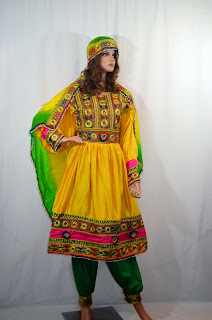As a chiefly rural and nomadic population, the Pashtun dress of Afghanistan is typically made from light linens, and are loose fitting for ease of movement. The Pashtun dress includes local forms of the shalwar kameez, which are differently made for males and females.
The traditional male dress includes the Khet partug and Perahan wa tunban. Males usually wear kufi, Peshawari cap, turban, sindhi cap or pakul as traditional headgear. Leaders sometimes wear a karakul hat, like President Hamid Karzai and former monarchs of Afghanistan.
The traditional female dress is the firaq and partūg. Women typically wear solid-coloured trousers, a long kamīs shirt with a belt. Sometimes they will wear an encompassing burqa over this outfit or a tsādar on their head.
More elaborate and fancier dresses are detailed with gold threading, gold beads, and come in many different colors on silk fabrics. These dresses are usually worn to special occasions and weddings.
Many of the co-ethnic groups who live alongside the Pasthuns in Afghanistan, Pakistan and Iran have also adopted the dress because of comfort or popular culture.
The traditional male dress includes the Khet partug and Perahan wa tunban. Males usually wear kufi, Peshawari cap, turban, sindhi cap or pakul as traditional headgear. Leaders sometimes wear a karakul hat, like President Hamid Karzai and former monarchs of Afghanistan.
The traditional female dress is the firaq and partūg. Women typically wear solid-coloured trousers, a long kamīs shirt with a belt. Sometimes they will wear an encompassing burqa over this outfit or a tsādar on their head.
More elaborate and fancier dresses are detailed with gold threading, gold beads, and come in many different colors on silk fabrics. These dresses are usually worn to special occasions and weddings.
Many of the co-ethnic groups who live alongside the Pasthuns in Afghanistan, Pakistan and Iran have also adopted the dress because of comfort or popular culture.
 |
| Traditional Afghan Clothes |
 |
| Traditional Afghan Clothes |
 |
| Gulpari is a gorgeous fancy formal Afghan dress for any special occasion and look stunning. Gulpari comes with green pants and a multicolor chador (head scarf). |
 |
| Gorgeous, luxurious Afghan dress, decorated with a beautiful golden embroidered pattern. Comes with an equally beautiful, embroidered scarf, and matching pants. |


HOME





.0.jpg)








